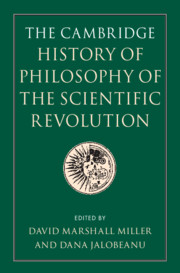Book contents
- The Cambridge History of Philosophy of the Scientific Revolution
- The Cambridge History of Philosophy of the Scientific Revolution
- Copyright page
- Contents
- Tables and Figures
- Contributors
- Preface
- Introduction The Disciplinary Revolutions of Early Modern Philosophy and Science
- Part I The Disciplines
- Part II Disciplinary Activities
- 8 The Art of Thinking
- 9 Astrology, Natural Magic, and the Scientific Revolution
- 10 Practitioners’ Knowledge
- 11 Medicine and the Science of the Living Body
- 12 Experimental Natural History
- 13 Celestial Physics
- 14 Applying Mathematics to Nature
- 15 Mathematical Innovation and Tradition: The Cartesian Common and the Leibnizian New Analyses
- 16 Mechanics in Newton’s Wake
- Part III Problems and Controversies
- Bibliography
- Index
11 - Medicine and the Science of the Living Body
from Part II - Disciplinary Activities
Published online by Cambridge University Press: 14 January 2022
- The Cambridge History of Philosophy of the Scientific Revolution
- The Cambridge History of Philosophy of the Scientific Revolution
- Copyright page
- Contents
- Tables and Figures
- Contributors
- Preface
- Introduction The Disciplinary Revolutions of Early Modern Philosophy and Science
- Part I The Disciplines
- Part II Disciplinary Activities
- 8 The Art of Thinking
- 9 Astrology, Natural Magic, and the Scientific Revolution
- 10 Practitioners’ Knowledge
- 11 Medicine and the Science of the Living Body
- 12 Experimental Natural History
- 13 Celestial Physics
- 14 Applying Mathematics to Nature
- 15 Mathematical Innovation and Tradition: The Cartesian Common and the Leibnizian New Analyses
- 16 Mechanics in Newton’s Wake
- Part III Problems and Controversies
- Bibliography
- Index
Summary
This chapter outlines important theoretical and methodological facets of elite medicine in the sixteenth and seventeenth centuries, and traces some developments in each, highlighting their significance for the history and philosophy of the Scientific Revolution. The chapter looks first at “theoretical” questions (centered on medical physiologia), tracing interactions between various Galenic, chymical, and mechanical streams of thought. It then turns to “methodological” issues, examining changing understandings of and roles for observation, experience, and experiment, with some special attention on method in anatomy. Throughout the Scientific Revolution, these theoretical and methodological developments interacted in complex and productive ways. Indeed, it is perhaps best to see medical efforts to develop the science of the living body in this period as an exploration of the changing space of possibilities defined by varying theoretical commitments and a broadening commitment to, expectation of, and attention to discovery by experience and experiment.
Keywords
- Type
- Chapter
- Information
- The Cambridge History of Philosophy of the Scientific Revolution , pp. 201 - 221Publisher: Cambridge University PressPrint publication year: 2022



